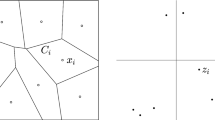Abstract
We derive exact analytical expressions for flow configurations that optimize the instantaneous growth rate of energy in the linear Eady problem, along with the associated growth rates. These optimal perturbations are relevant linear stability analysis, but, more importantly, they are relevant for understanding the energetics of fully nonlinear baroclinic turbulence. The optimal perturbations and their growth rates are independent of the Richardson number. The growth rates of the optimal perturbations grow linearly as the horizontal wavelength of the perturbation decreases. Perturbation energy growth at large scales is driven by extraction of potential energy from the mean flow, while at small scales it is driven by extraction of kinetic energy from the mean shear. We also analyze the effect of spatial discretization on the optimal perturbations and their growth rates. A second-order energy-conserving discretization on the Arakawa B grid generally has too weak growth rates at small scales and is less accurate than two second-order discretizations on the Arakawa C grid. The two C-grid discretizations, one that conserves energy and another that conserves both energy and enstrophy, yield very similar optimal perturbation growth rates that are significantly more accurate than the B-grid discretization at small scales.
Similar content being viewed by others
References
Arakawa, A., Lamb, V.R.: Computational design of the basic dynamical processes of the UCLA general circulation model. Methods Comput. Phys. 17, 173–265 (1977)
Arakawa, A., Lamb, V.R.: A potential enstrophy and energy conserving scheme for the shallow water equations. Mon. Weather Rev. 109(1), 18–36 (1981)
Arakawa, A., Moorthi, S.: Baroclinic instability in vertically discrete systems. J. Atmos. Sci. 45(11), 1688–1708 (1988)
Barham, W., Bachman, S., Grooms, I.: Some effects of horizontal discretization on linear baroclinic and symmetric instabilities. Ocean Model. 125, 106–116 (2018)
Bell, M.J., White, A.A.: Spurious stability and instability in n-level quasi-geostrophic models. J. Atmos. Sci. 45(11), 1731–1738 (1988)
Bell, M.J., White, A.A.: Analytical approximations to spurious short-wave baroclinic instabilities in ocean models. Ocean Model. 118, 31–40 (2017)
Böberg, L., Brösa, U.: Onset of turbulence in a pipe. Z. Naturforsch. 43(8–9), 697–726 (1988)
Bryan, K.: A numerical method for the study of the circulation of the world ocean. J. Comput. Phys. 4(3), 347–376 (1969)
Capet, X., Roullet, G., Klein, P., Maze, G.: Intensification of upper-ocean submesoscale turbulence through Charney baroclinic instability. J. Phys. Ocean. 46(11), 3365–3384 (2016)
DelSole, T.: The necessity of instantaneous optimals in stationary turbulence. J. Atmos. Sci. 61(9), 1086–1091 (2004)
Ducousso, N., Le Sommer, J., Molines, J.M., Bell, M.: Impact of the symmetric instability of the computational kind at mesoscale-and submesoscale-permitting resolutions. Ocean Model. 120, 18–26 (2017)
Eady, E.T.: Long waves and cyclone waves. Tellus 1(3), 33–52 (1949)
Farrell, B.: Modal and non-modal baroclinic waves. J. Atmos. Sci. 41(4), 668–673 (1984)
Farrell, B.: Transient growth of damped baroclinic waves. J. Atmos. Sci. 42(24), 2718–2727 (1985)
Farrell, B.F.: Optimal excitation of baroclinic waves. J. Atmos. Sci. 46(9), 1193–1206 (1989)
Farrell, B.F., Ioannou, P.J.: Generalized stability theory. Part I: autonomous operators. J. Atmos. Sci. 53(14), 2025–2040 (1996)
Ferrari, R., Wunsch, C.: Ocean circulation kinetic energy: reservoirs, sources, and sinks. Ann. Rev. Fluid Mech. 41, 253–282 (2009)
Griffies, S.M.: Fundamentals of Ocean Climate Models. Princeton University Press, Princeton (2004)
Grooms, I.: Submesoscale baroclinic instability in the balance equations. J. Fluid Mech. 762, 256–272 (2015)
Haidvogel, D.B., Beckmann, A.: Numerical Ocean Circulation Modeling, vol. 2. World Scientific, Singapore (1999)
Hollingsworth, A., Kållberg, P., Renner, V., Burridge, D.M.: An internal symmetric computational instability. Q. J. R. Meteorol. Soc. 109(460), 417–428 (1983)
Kalashnik, M.V., Chkhetiani, O.: An analytical approach to the determination of optimal perturbations in the Eady model. J. Atmos. Sci. 75, 2741–2761 (2018)
Le Sommer, J., Penduff, T., Theetten, S., Madec, G., Barnier, B.: How momentum advection schemes influence current-topography interactions at eddy permitting resolution. Ocean Model. 29(1), 1–14 (2009)
Madec, G.: NEMO ocean engine. Note du Pôle de modélisation, Institut Pierre-Simon Laplace (IPSL), France, No 27, ISSN No 1288–1619 (2008)
Marshall, J., Adcroft, A., Hill, C., Perelman, L., Heisey, C.: A finite-volume, incompressible Navier–Stokes model for studies of the ocean on parallel computers. J. Geophys. Res. Oceans 102(C3), 5753–5766 (1997)
Rocha, C.B., Young, W.R., Grooms, I.: On Galerkin approximations of the surface active quasigeostrophic equations. J. Phys. Ocean. 46(1), 125–139 (2016)
Roullet, G., McWilliams, J.C., Capet, X., Molemaker, M.J.: Properties of steady geostrophic turbulence with isopycnal outcropping. J. Phys. Ocean. 42(1), 18–38 (2012)
Schmid, P.J.: Nonmodal stability theory. Ann. Rev. Fluid Mech. 39, 129–162 (2007)
Schmid, P.J., Henningson, D.S.: Stability and Transition in Shear Flows. Springer, New York (2001)
Smith, K.S.: The geography of linear baroclinic instability in Earth’s oceans. J. Mar. Res. 65(5), 655–683 (2007)
Smith, R., Jones, P., Briegleb, B., Bryan, F., Danabasoglu, G., Dennis, J., Dukowicz, J., Eden, C., Fox-Kemper, B., Gent, P., et al.: The parallel ocean program (POP) reference manual. Los Alamos National Lab Technical Report 141, (2010)
Stone, P.H.: On non-geostrophic baroclinic stability. J. Atmos. Sci. 23(4), 390–400 (1966)
Stone, P.H.: On non-geostrophic baroclinic stability: Part II. J. Atmos. Sci. 27(5), 721–726 (1970)
Trefethen, L.N., Embree, M.: Spectra and Pseudospectra of Nonnormal Matrices and Operators. Princeton University Press, Princeton (2005)
Tulloch, R., Marshall, J., Hill, C., Smith, K.S.: Scales, growth rates, and spectral fluxes of baroclinic instability in the ocean. J. Phys. Ocean. 41(6), 1057–1076 (2011)
Vallis, G.K.: Atmospheric and Oceanic Fluid Dynamics: Fundamentals and Large-Scale Circulation, 2nd edn. Cambridge University Press, Cambridge (2017)
Author information
Authors and Affiliations
Corresponding author
Additional information
Communicated by William Dewar.
Publisher's Note
Springer Nature remains neutral with regard to jurisdictional claims in published maps and institutional affiliations.
WB is supported by the US National Science Foundation grant DMS 1407340.
Rights and permissions
About this article
Cite this article
Barham, W., Grooms, I. Exact instantaneous optimals in the non-geostrophic Eady problem and the detrimental effects of discretization. Theor. Comput. Fluid Dyn. 33, 125–139 (2019). https://doi.org/10.1007/s00162-019-00488-w
Received:
Accepted:
Published:
Issue Date:
DOI: https://doi.org/10.1007/s00162-019-00488-w




